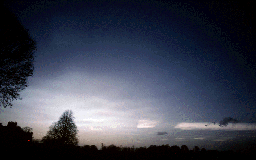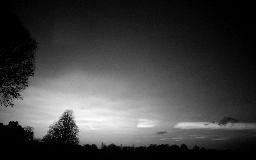


A display of nacreous or mother of pearl clouds were widely seen across the UK on the evening of February 16 1996. These clouds form in the stratosphere, at heights of between 10 and 30 km, when the temperature there falls below -80 oC and are probably composed of ice particles with a liquid coating of nitric acid tri- hydrate. They appear bright because they are high enough to be illuminated by the sun long after local sunset and the pastel colours arise through diffraction or interference effects in much the same way that colours appear in a film of oil on a puddle of water.
Occasionally seen from Scotland during the winter months, they are a once in a lifetime sighting from southern England. They are more frequently seen from the southern hemisphere, particularly from locations along the Antarctic Peninsula where the mountains create lee-waves in the upper atmosphere. Stratospheric clouds are associated with ozone depletion as they create the necessary environment for the chlorine based catalytic photochemistry that destroys ozone at around 1% per day. Fortunately the conditions rarely last more than a week in the northern hemisphere, but temperatures in the southern hemisphere are around 10 degrees colder and the clouds can persist for several months, creating the Antarctic ozone hole.
In fact, low ozone values have been observed over the UK in late February/early March 1996. This is consistent with the presence of the clouds, but it is not yet clear whether the low ozone is dynamic (of tropical origin) or chemical (from ozone depletion). Images of TOMS ozone are available from NOAA, with some individual days: February: 18, 23, 28, March: 2, 6. The lowered ozone values might be expected to lead to higher levels of UV (ultra-violet) radiation at the ground. Unfortunately, the days of interest were cloudy and so no useful comparison of UV levels can be made to climatological values from previous years.
The images shows dense nacreous clouds to the right, with the centre one showing some of the mother of pearl colours. On the left are more diffuse stratospheric clouds which show a structure similar to stratocumulus. A pink coloured aircraft contrail crosses the denser clouds and some dark tropospheric clouds are at extreme right.
Images. Left: Colour (140 k). Right: B&W (110 k). The colours are very subtle and don't show well even on a very good display. On a poor display the B&W picture shows the structure better than the colour.